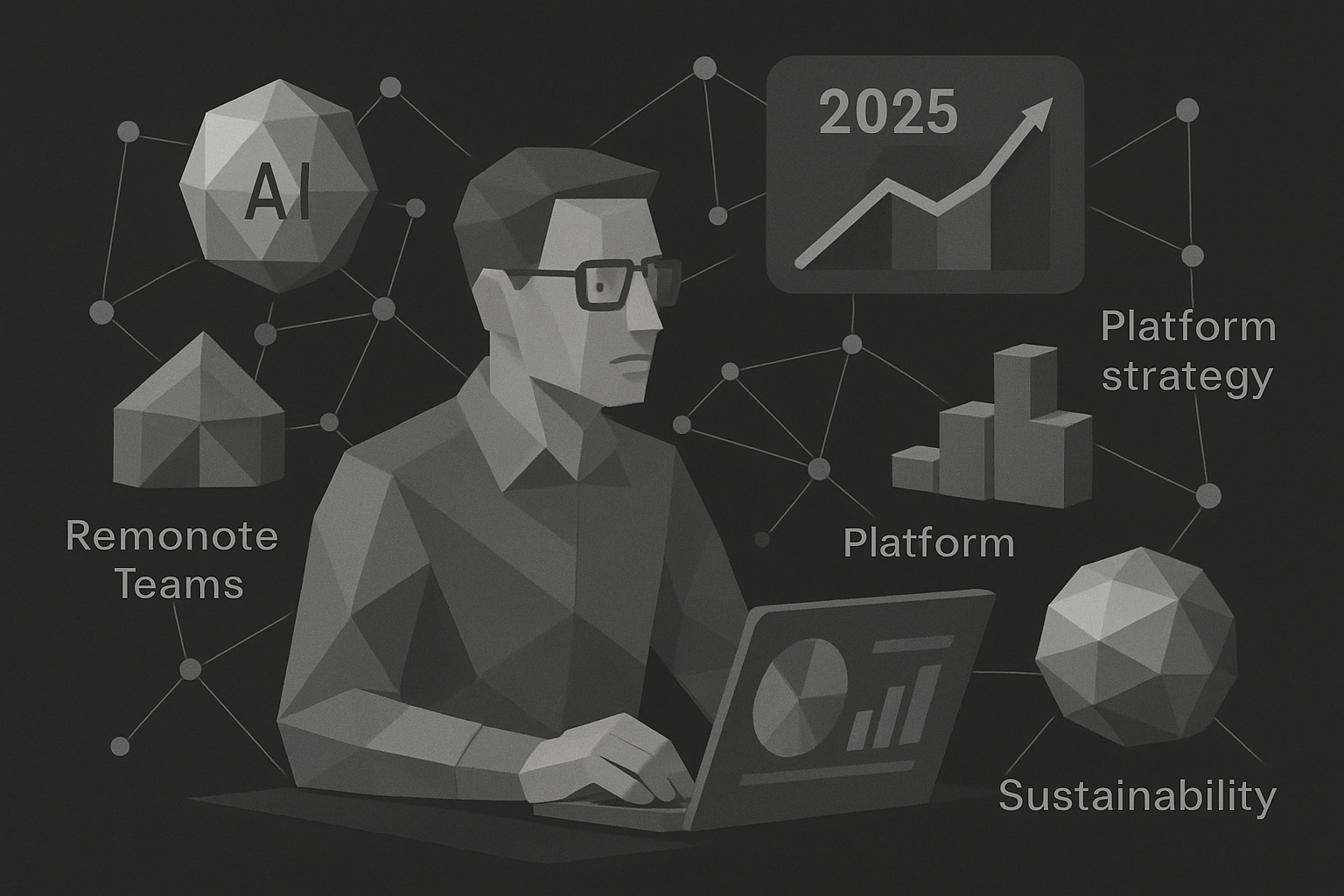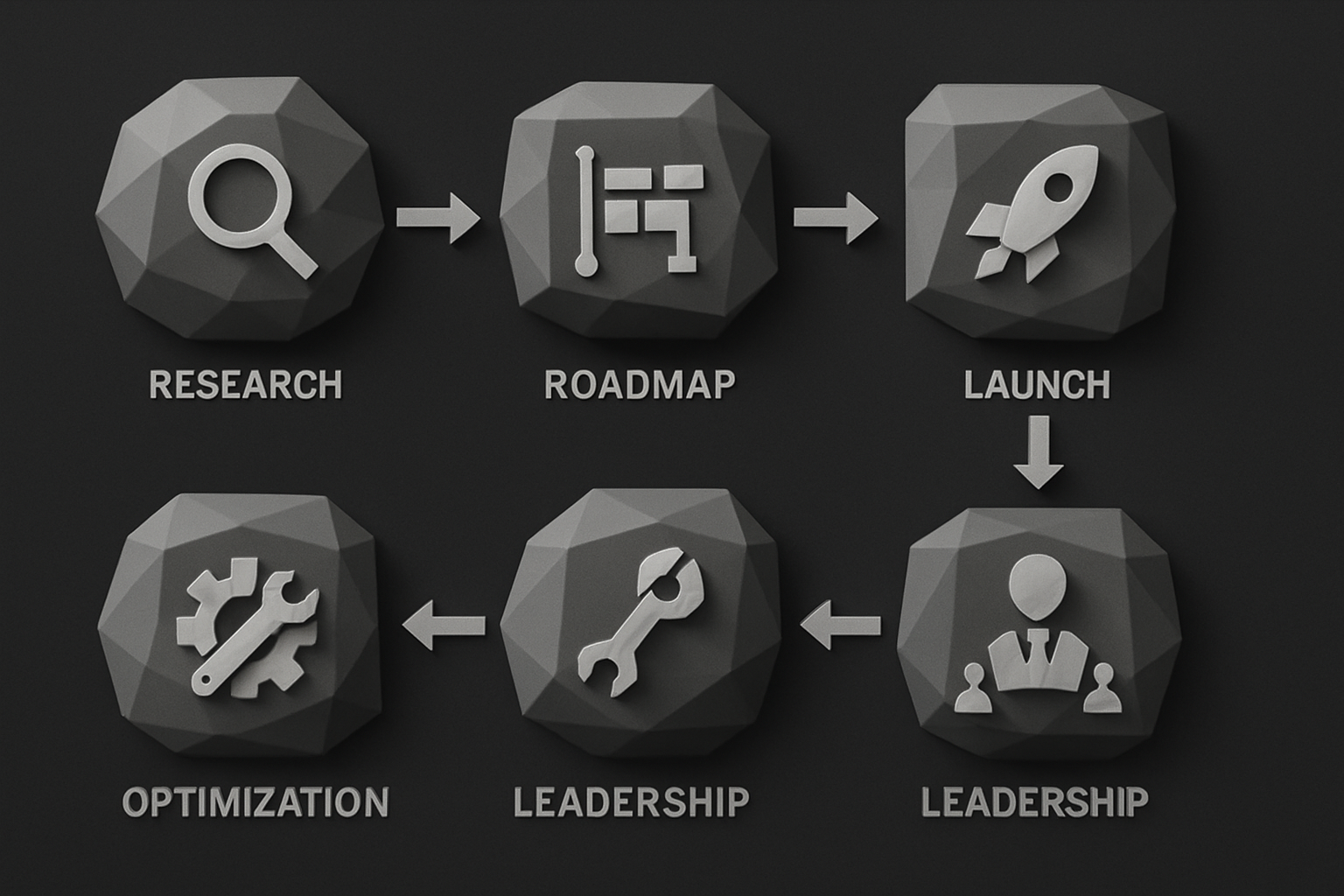In a world where digital transformation is accelerating, mastering digital product management is more crucial than ever. Organizations are racing to keep pace with innovation and shifting customer needs.
This guide will explore the strategies, frameworks, and skills you need to excel. We’ll look at how the role of digital product managers is evolving, highlight emerging trends, and break down proven methodologies for success.
You’ll discover actionable insights, industry best practices, and real-world examples to help you lead and grow in this dynamic field.
Ready to future-proof your skills? Let’s dive in and unlock the future of digital product management together.
The Evolving Role of Digital Product Management in 2025
The landscape of digital product management is transforming rapidly as we approach 2025. With the digital economy booming, organizations are rethinking how they develop, launch, and scale products. The role of the digital product manager is at the center of this transformation, bridging strategy, technology, and user experience to drive business value.

Defining Digital Product Management
Digital product management is the discipline of guiding a digital product from ideation to market success, distinct from traditional product management by its reliance on technology, data, and rapid innovation cycles. Unlike legacy approaches, it requires leaders to orchestrate across strategy, operations, research, finance, marketing, and data analysis—a truly cross-functional role, as highlighted by MIT Sloan.
Gartner defines digital business as the creation of new business designs using digital technologies to blur boundaries between the physical and virtual worlds. Digital product management is the operational engine behind this shift. For example, in SaaS, fintech, or e-commerce, digital product managers oversee everything from initial concept to launch, ensuring products meet user needs and business goals.
To explore how these trends are shaping the role in 2025, see Product Management Trends 2025.
Key Responsibilities and Skills for Modern Product Managers
Professionals in digital product management must master a diverse set of responsibilities. They set a strategic vision, maintain a customer-centric approach, and rely on data-driven decision-making to guide product direction.
Key skills for today’s digital product managers include:
- Agile leadership and cross-functional collaboration
- Technical fluency, especially with emerging technologies
- Strong communication and stakeholder management
- Analytical thinking and business acumen
In digital-first organizations, product managers are often seen as “mini-CEOs,” responsible for balancing user needs, business objectives, and technical feasibility.
The Rise in Demand and Career Paths
Demand for digital product management talent is surging, with it now being the second-largest job category for MIT Sloan graduates. This trend is seen across technology, finance, healthcare, and retail, as businesses increasingly prioritize digital transformation.
Career paths in digital product management are diverse. Many start as Associate Product Managers, then move up to Product Manager, Senior PM, and eventually to Chief Product Officer. It’s common for professionals to transition from engineering or project management roles, bringing unique perspectives to the product discipline.
| Career Path Example | Previous Role | Next Step |
|---|---|---|
| APM to PM | Project Manager | Associate PM |
| PM to Senior PM | Software Engineer | Product Manager |
| Senior PM to CPO | Product Manager | Chief Product Officer |
How Digital Product Management Impacts Business Success
Digital product management is a catalyst for business success. It drives innovation, accelerates time-to-market, and ensures products are closely aligned with customer needs. By connecting business strategy with user insights, digital product managers help organizations capture new market opportunities.
Consider a case study: A fintech company launches a mobile payments app, guided by a digital product management team. Through rigorous user research and iterative development, the team delivers a solution that fills a market gap, resulting in significant new market share and increased customer loyalty.
Challenges Facing Digital Product Managers in 2025
Despite its rewards, digital product management faces notable challenges in 2025. Rapid technological changes and market volatility require constant adaptation. Managers must balance diverse stakeholder interests and navigate tight resource constraints.
Other challenges include:
- Managing distributed and remote teams
- Adapting to AI-driven disruptions
- Staying ahead of regulatory changes
For example, as AI and automation reshape industries, digital product managers must ensure their teams are agile and ready to pivot. Regulatory shifts in data privacy, especially in fintech and healthcare, add further complexity to the role.
Emerging Trends in Digital Product Management
Digital product management is evolving rapidly, with new trends shaping how teams build, launch, and scale digital products. Staying ahead of these changes is essential for product leaders aiming to deliver outstanding results in 2025.

AI, Automation, and Data-Driven Product Decisions
AI is revolutionizing digital product management by automating everything from feature prioritization to user insights. Product managers now leverage machine learning for predictive analytics, enabling smarter, faster decisions. Tools powered by AI can automate A/B testing, analyze user feedback, and even generate product roadmaps. For example, AI-driven platforms help teams uncover hidden patterns in user data and optimize features in real time. According to AI in Product Management, these advancements empower product managers to focus on strategic work rather than repetitive tasks. Embracing AI is becoming a necessity for competitive digital product management.
Product-Led Growth and Customer-Centricity
A major shift in digital product management is the move toward product-led growth. Instead of relying on traditional sales teams, organizations now focus on creating products that drive user acquisition and retention through superior experiences. Product managers analyze usage data to identify what delights users and where friction exists. Freemium SaaS models—where users can try before they buy—are classic examples of how product experience fuels growth. This approach allows digital product management teams to iterate quickly, using real-time feedback to enhance the product and boost conversions. Customer-centricity is no longer optional; it’s the foundation of sustainable growth.
Remote and Hybrid Product Teams
The rise of remote and hybrid work models has transformed digital product management. Managing distributed teams requires mastery of digital collaboration tools and asynchronous communication. Successful product managers implement rituals like virtual stand-ups, retrospectives, and transparent documentation. This approach ensures alignment, even across time zones. For instance, remote-first companies have launched global products without ever meeting in person. Embracing flexibility in team structure is now a core competency in digital product management, helping organizations tap into diverse talent and respond swiftly to market changes.
Platform Strategy and Ecosystem Thinking
Digital product management is increasingly about building platforms rather than standalone products. Platforms enable third-party integrations, foster network effects, and create new revenue streams. Product managers must understand ecosystem dynamics—how partners, developers, and users interact. For example, app marketplaces and API-driven services are central to many modern business models. Adopting a platform mindset allows digital product management teams to scale rapidly and adapt to changing user needs. Ecosystem thinking encourages collaboration and innovation, positioning products for long-term success.
Sustainability and Ethical Product Management
Sustainability is becoming a non-negotiable aspect of digital product management. Leading teams incorporate environmental and social considerations into every stage of the product lifecycle. This includes designing for energy efficiency, minimizing waste, and ensuring accessibility. Ethical product management also means addressing issues like data privacy and algorithmic bias. Digital product management teams are now expected to track ESG (Environmental, Social, Governance) metrics and demonstrate responsible innovation. Products that prioritize ethics and sustainability not only comply with regulations but also build lasting trust with users.
Step-by-Step Guide to Successful Digital Product Management in 2025
Mastering digital product management in 2025 requires a structured, adaptable approach. Each step below outlines the essential actions, skills, and tools you’ll need to deliver standout results in today’s fast-moving digital landscape.

Step 1: Market and User Research
The foundation of effective digital product management is deep market and user research. Start by gathering both quantitative and qualitative insights. Use surveys, interviews, and analytics tools to understand user pain points and behaviors.
Leverage platforms like Google Analytics and Hotjar for data and heatmaps. For deeper analysis, tools such as R or Python provide robust statistical methods, as taught in MIT Sloan’s Analytics Edge. Validate the problem-solution fit early to avoid costly pivots later.
Best practices include:
- Continuous discovery cycles
- Stakeholder interviews
- Competitor benchmarking
For a comprehensive look at building and validating ideas, check out the Building Digital Products Guide. This foundational research is critical in digital product management, ensuring your solutions truly address market needs.
Step 2: Strategic Product Planning and Roadmapping
Strategic planning is at the heart of digital product management. Define a clear vision, set measurable goals, and align your KPIs with business strategy. Outcome-oriented roadmaps help teams stay focused while adapting to change.
Prioritize features using frameworks like RICE, MoSCoW, or Kano. These methods bring objectivity to decision-making and keep your efforts user-centric. In digital product management, data-driven roadmap adjustments ensure you respond quickly to feedback or market shifts.
Align with stakeholders early and often. Share roadmaps transparently using tools like Aha! or Productboard. A well-structured roadmap is a living document, evolving as you learn.
Step 3: Agile Development and Iterative Delivery
Digital product management thrives on agility. Implement methodologies such as Scrum or Kanban to foster rapid, iterative progress. Agile ceremonies—sprints, standups, retrospectives—keep teams connected and projects moving forward.
Continuous integration and deployment are vital. By managing MVPs and prototypes, you can deliver value incrementally and gather feedback fast. In digital product management, cross-functional squads (engineering, design, QA) collaborate to release features efficiently.
Track progress with agile metrics like velocity and cycle time. These indicators help you identify bottlenecks and optimize delivery, ensuring your team adapts swiftly to change.
Step 4: Launch, Go-to-Market, and Growth
A successful launch demands coordination across marketing, sales, and support. Digital product management professionals plan go-to-market strategies using digital marketing, sales enablement, and partnerships.
Growth hacking techniques—viral loops, referral programs, A/B tests—accelerate user acquisition. Use analytics tools to monitor performance, adjusting tactics in real time. Social media analytics reveal which channels and messages drive engagement.
Post-launch, iterate based on user feedback and data. Digital product management is an ongoing cycle of launching, learning, and optimizing. Celebrate wins, but keep improving.
Step 5: Product Optimization and Lifecycle Management
Optimizing your product for long-term success is essential in digital product management. Analyze user behavior to uncover opportunities for feature enhancements. Use cohort analysis and funnel metrics to identify drop-off points.
Managing technical debt and scalability ensures your product remains reliable as it grows. Plan for the sunset of legacy features to keep your offering lean. Lifecycle investing, a concept from asset management, applies well to digital assets.
Foster a culture of continuous improvement. Encourage your team to suggest optimizations and celebrate incremental gains in digital product management.
Step 6: Stakeholder Management and Cross-Functional Leadership
Digital product management is as much about people as it is about products. Build strong relationships across engineering, design, marketing, and sales. Facilitate effective meetings, encouraging open dialogue and clear action items.
Develop negotiation and conflict resolution skills to navigate competing interests. Lead by example—foster ownership, accountability, and a shared vision. Innovation flourishes when teams feel empowered to contribute.
Finally, create structures for decision-making and recognition. In digital product management, leaders inspire teams to reach new heights together.
Leveraging Technology and Tools for Digital Product Management
In today’s rapidly evolving landscape, leveraging the right technology and tools can make or break your digital product management success. With new challenges emerging in 2025, product managers must harness platforms that drive efficiency, foster collaboration, and ensure security.

Essential Product Management Tools and Platforms
Modern digital product management relies on a stack of specialized tools to keep teams aligned and workflows seamless. Roadmapping platforms like Aha! and Productboard help visualize strategy, while Jira streamlines agile development. For user analytics, Amplitude, Mixpanel, and Google Analytics offer deep insights into user behavior and product performance.
Collaboration is critical—Slack, Miro, and Confluence drive clear communication, brainstorming, and documentation. Marketing tools are also crucial for digital product management, especially when planning go-to-market strategies. Discover the most effective options in Best Digital Marketing Tools.
| Tool Type | Examples | Purpose |
|---|---|---|
| Roadmapping | Aha!, Productboard, Jira | Strategy & planning |
| Analytics | Amplitude, Mixpanel, GA | User insights |
| Collaboration | Slack, Miro, Confluence | Team alignment |
Harnessing AI and Automation in Product Management
AI and automation are revolutionizing digital product management by enabling smarter, faster decisions. AI-driven segmentation helps identify high-value users, while predictive analytics forecast churn and highlight retention opportunities. Automation tools streamline repetitive tasks—think automated feedback loops or real-time reporting—freeing up time for strategic work.
For example, machine learning models can recommend product features based on historical user data. Integrating these AI capabilities into your digital product management workflow ensures your team stays ahead of the curve and can respond rapidly to market demands.
Data Analytics and Experimentation
Data-driven experimentation sits at the heart of digital product management. Running A/B and multivariate tests allows teams to validate new features before full-scale rollout. Cohort analysis uncovers trends in user behavior, and funnel metrics identify bottlenecks and opportunities for growth.
A simple code example for running an A/B test in Python:
import scipy.stats as stats
# Compare conversion rates of two variants
stats.ttest_ind(variant_a, variant_b)
By embedding experimentation into your digital product management process, you can iterate quickly and optimize for real business impact.
Security, Compliance, and Privacy Considerations
Security and privacy are non-negotiable in digital product management, especially with evolving regulations like GDPR and CCPA. Embedding privacy-by-design principles from day one ensures user data is handled responsibly. Compliance tools help manage consent, track policy updates, and audit data practices.
For fintech and healthcare digital product management, protecting sensitive information is vital. Always involve legal and security experts early in the process to anticipate risks and maintain trust. Prioritizing security not only safeguards users but also strengthens your product’s reputation.
Building and Leading High-Performance Product Teams
Building a high-performance team is crucial for digital product management success. Effective teams drive innovation, adaptability, and long-term business value. Let’s break down the core pillars of world-class product teams and how to lead them in today’s fast-paced digital landscape.
Recruiting and Developing Product Talent
The foundation of digital product management lies in recruiting talent with both technical and strategic prowess. Seek individuals who blend analytical thinking, creativity, and empathy for users. Prioritize diversity to ensure a broad viewpoint and stronger product outcomes.
Key competencies to look for include:
- Strategic mindset and business acumen
- Technical fluency and adaptability
- Strong communication and collaboration skills
- Data-driven decision-making
Onboarding should immerse new hires in your product vision and workflow. Ongoing coaching and mentorship accelerate growth. For deeper insight into the design side, explore Designing Effective Digital Products to understand design strategies vital for product managers.
Fostering a Culture of Innovation and Collaboration
High-performing digital product management teams thrive in environments that encourage curiosity and experimentation. Leaders play a pivotal role in establishing psychological safety, where team members feel empowered to share bold ideas and learn from failure.
Ways to nurture innovation:
- Celebrate experimentation and calculated risk-taking
- Use structured processes like design sprints or hackathons
- Promote cross-disciplinary collaboration between design, engineering, and business
Regularly spotlighting small wins and collaborative breakthroughs fuels ongoing motivation. When innovation is woven into the culture, digital product management teams are better equipped to deliver breakthrough products.
Managing Remote and Global Teams
Today’s digital product management often operates with distributed teams across time zones. Clear communication and intentional rituals help bridge distance and cultural gaps.
Best practices for remote teams:
- Use collaboration platforms for transparent updates and documentation
- Schedule regular check-ins and asynchronous stand-ups
- Recognize achievements across locations to foster unity
Leverage digital whiteboards and shared roadmaps to keep everyone aligned. By focusing on inclusivity and open communication, digital product management leaders can harness the strengths of a global workforce.
Upskilling and Continuous Learning
In digital product management, the learning never stops. The pace of change demands that teams and individuals stay ahead of industry trends, emerging tools, and methodologies.
Invest in:
- Product management certificates and workshops
- Peer learning, mentorship, and professional communities
- Regular knowledge-sharing sessions within the team
Encourage team members to attend webinars or take on stretch projects. Continuous learning ensures your digital product management team remains agile and ready for future challenges.
Future-Proofing Your Digital Product Strategy for 2025 and Beyond
Navigating the future of digital product management requires a proactive mindset and a toolkit built for rapid change. Successful leaders anticipate shifts, build resilient strategies, measure impact, scale wisely, and invest in continuous growth. Let’s break down how you can future-proof your digital product management approach for 2025 and beyond.
Anticipating Market Shifts and Disruptions
Staying ahead in digital product management means constantly monitoring market trends and competitor innovations. Rapid advances, like generative AI and new regulations, can change the landscape overnight. Product managers must regularly scan the horizon, engage with industry reports, and leverage scenario planning to prepare for uncertainty.
For example, teams that quickly adapted to the rise of AI tools in 2024 gained a competitive edge. By embedding trend analysis into your workflow, you ensure your digital product management strategies remain relevant as new technologies and customer expectations evolve.
Building Resilient and Adaptable Product Strategies
Resilience in digital product management comes from flexible frameworks and a willingness to pivot. Modular design and agile processes enable teams to adjust quickly when user feedback or market dynamics shift. Incorporating sustainable business models, like those outlined in Recurring Revenue Model Strategies, can help create stability even in volatile times.
Digital product management thrives when teams embrace change, test new ideas, and refine their approach based on real-world data. The most successful organizations don’t just react—they anticipate and adapt.
Measuring and Communicating Product Impact
Impactful digital product management hinges on tracking the right metrics and sharing results across the organization. Key indicators like Net Promoter Score (NPS), annual recurring revenue (ARR), and retention rates offer a clear picture of product success.
Data storytelling is essential when presenting outcomes to stakeholders or executive teams. By connecting metrics with business goals, product managers foster alignment and secure buy-in for future initiatives. Regular reporting ensures everyone stays focused on delivering value.
Scaling Products and Teams Sustainably
Scaling is a critical phase in digital product management. Growth must be balanced with maintaining product quality and user satisfaction. Frameworks such as platform strategy and modular architectures help products evolve without becoming unwieldy.
Leveraging cloud technologies is vital for efficient scaling. As discussed in Cloud Optimization in 2025, optimizing your cloud infrastructure can boost performance, control costs, and enhance security—all essential for sustainable product growth.
Investing in Personal and Team Growth
Continuous learning is at the heart of digital product management. Leaders should encourage mentorship, invest in ongoing education, and foster a culture where upskilling is valued. Networking with peers and joining professional communities provides exposure to fresh ideas and best practices.
Personal development, paired with team training, ensures your organization stays ahead of industry shifts. Investing in growth fuels innovation and keeps your digital product management capabilities sharp.
Key Resources and Certification Opportunities
Building credibility in digital product management often starts with the right credentials and resources. Top certifications include:
| Certification | Institution | Benefit |
|---|---|---|
| Product Management Certificate | MIT Sloan | Industry-recognized, hands-on learning |
| Pragmatic Institute Certification | Pragmatic Institute | Practical frameworks, global network |
| Professional Scrum Product Owner | Scrum.org | Agile expertise, global standard |
Recommended resources include books, podcasts, and online communities focused on product leadership and innovation. Earning certifications and engaging with these materials can accelerate your digital product management career and open new doors.
You’ve just explored the key strategies and skills you’ll need to thrive as a digital product manager in 2025, from leading cross-functional teams to leveraging the latest tools and trends. If you’re ready to put these insights into action and start building your own self-sustaining digital product business, let’s take the next step together. Whether you’re new to digital products or looking to level up, you’ll find everything you need to kickstart your journey with CreateSell’s expert guidance and resources.
Get Started
Let’s turn your knowledge into real results—your future as a digital product leader starts here!